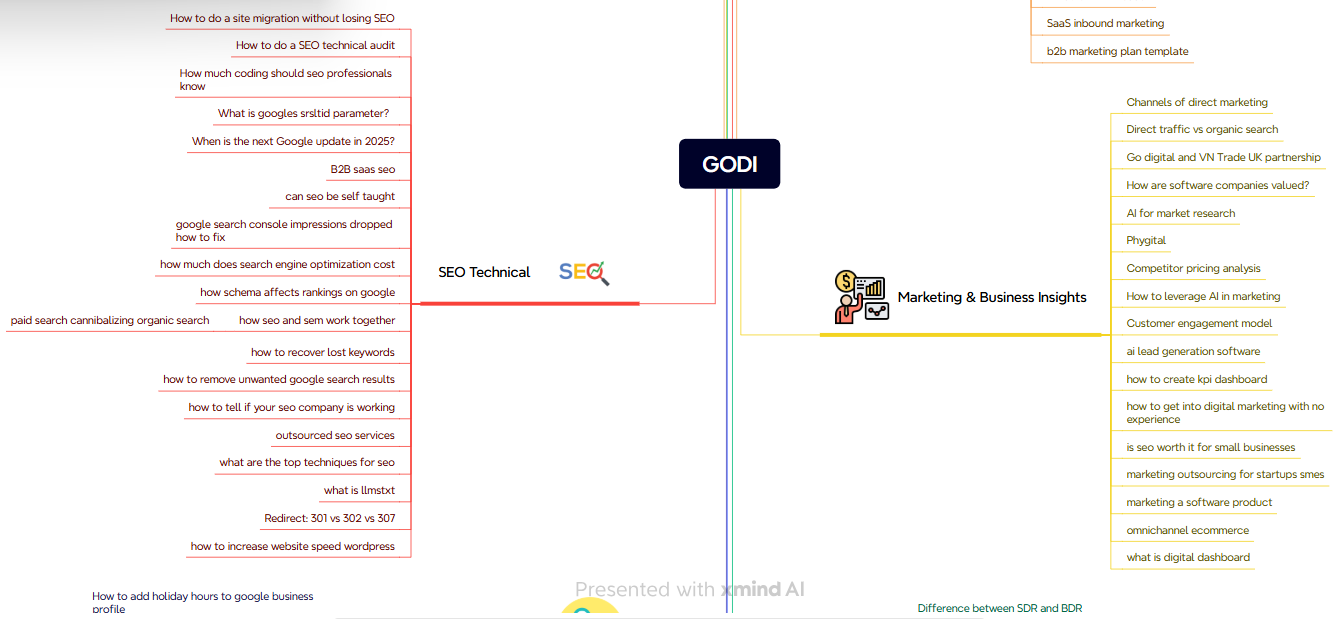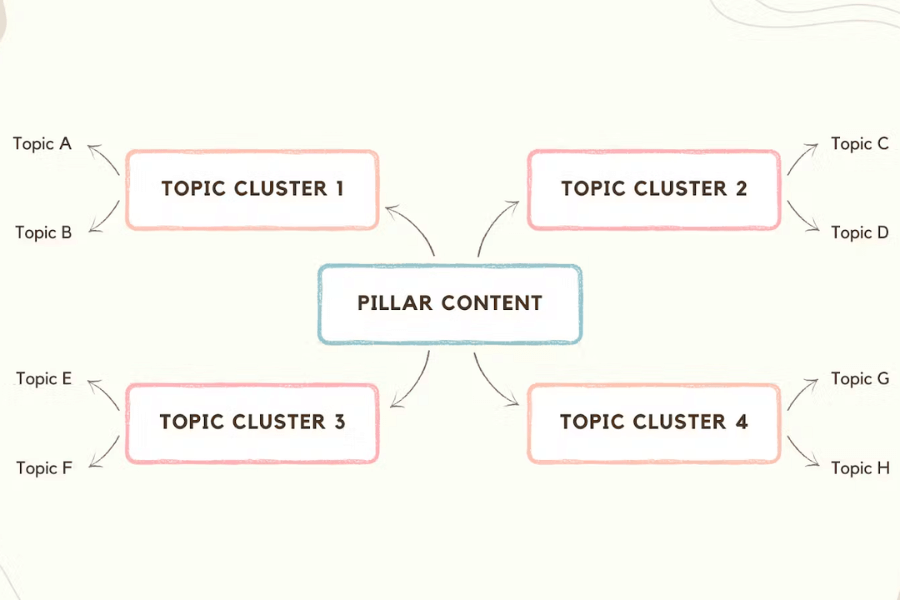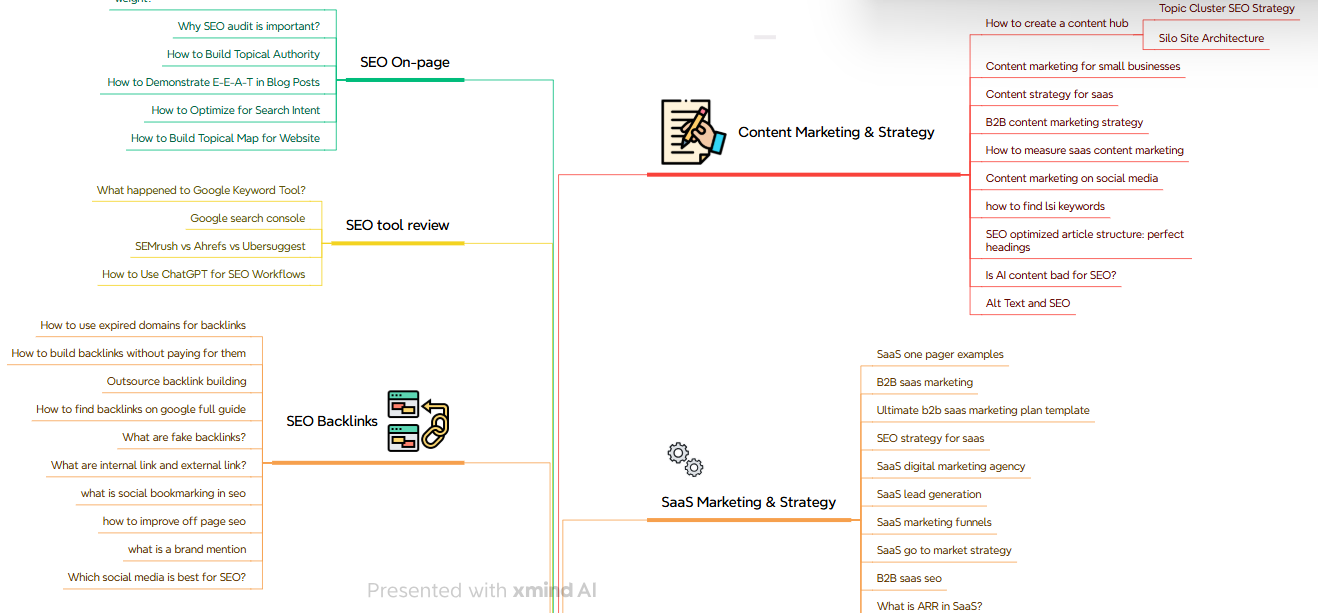If you want your website to dominate search results, publishing random blog posts isn’t enough. You need a strategy that organizes your topics and shows search engines that you’re an authority in your niche. This is where learning how to create a topical map fobecomes a game-changer.
In this guide, we’ll walk you through a step-by-step process on building topical map that drives traffic, improves rankings, and establishes you as an authority in your niche.
Key Takeaways:
|
What Is a Topical Map?
A topical map is a visual or structural representation of all the topics your website covers, along with the relationships between them.

A topical map is not just an SEO tool – it’s the blueprint for building a website
Instead of a scattered collection of articles, a topical map organizes your information into a cohesive content hub or content cluster interconnected network.
This provides a clear path for users to follow and signals to search engines like Google that your site has comprehensive knowledge on a given subject. The guide to semantic content organization on websites is the core idea behind this powerful structure.
For example, imagine you run a website about home coffee brewing. In your topical map, “Home Coffee Brewing” sits in the center. Each cluster has supporting articles linked to a pillar page. This creates content clusters for SEO, strengthens website architecture, and makes internal linking easier.
Why Build a Topical Map? (Key Benefits)

You can create a strong foundation by structuring content logically and covering topics in depth
A well‑planned topical map is more than an organizational tool, it’s a growth engine for your website. Learning how to build topical map for website helps you:
Here are the key benefits:
- Covers all relevant topics and avoids gaps: A topical map highlights missing content and ensures your website addresses every important angle of your niche.
- Streamlines keyword and content planning: Every page serves a clear purpose in your site structure, making it easier to target the right keywords and plan new articles.
- Increases chances to rank for more keywords: Google values websites that show expertise, experience, authority, and trust (E‑E‑A‑T). A well-structured topical map demonstrates that you’ve covered your subject thoroughly, helping both your pillar pages and supporting articles rank higher.
- Improves user experience: A logical content flow helps visitors find information quickly. Clear pathways encourage them to browse more pages, stay longer, and reduce bounce rates.
- Saves time and resources on SEO: Once your topical map is in place, you can create content with confidence, avoid duplication, and scale your SEO efforts efficiently.
When combined with the importance of silo structure in web development, a topical map reinforces both SEO performance and website usability.
Step-by-Step Guide: How to Create a Topical Map

How to build a website topical map step-by-step
Here’s a simple process to create and maintain a topical map that drives organic traffic.
Step 1: Define Your Core Topic
Identify the central theme your website should focus on. It should align with your brand, meet audience demand, and reflect your value proposition.
What is the central theme or subject of your business? This is your main pillar topic. For example, if you sell project management software, your core topic might be “Project Management.” This topic should be broad enough to encompass many subtopics but specific enough to be relevant to your business.
Step 2: Break Down Into Subtopics and Clusters

Divide your main topic into smaller, related areas
Each subtopic can become a content cluster with supporting posts.
Consider user intent:
- Informational: Guides and how-tos
- Transactional: Product or service-focused pages
- Navigational: Resources leading to core offerings
Mind mapping, competitor research, and audience surveys can help generate these clusters.
Step 3: Keyword Research & Query Mapping

With your subtopics defined, it’s time to dive into keyword research
Use tools like Ahrefs, SEMrush, or Google Keyword Planner to find relevant keywords and questions people are searching for within each subtopic.
- Use keyword tools (e.g., Ahrefs, Google Keyword Planner, SEMrush, SE Ranking) to find search queries linked to each subtopic.
- Group keywords by topic, volume, and search intent.
- Eliminate duplicates and spot unaddressed content opportunities (“content gaps”).
This ensures your topical map aligns with semantic content organization on websites and supports broad keyword coverage.
Step 4: Analyze Competitor Content Structure
Study high-ranking competitors to understand how they arrange clusters and internal links. Ask yourself:
- How deep is their topical coverage?
- Which strategies for internal linking in topic clusters do they use?
- Are there subtopics they missed where you can gain an edge?
Competitor analysis also helps with link-building ideas. See our guide on how to find backlinks on Google for additional insights.
Step 5: Visualize Your Topical Map
It’s time to create your visual blueprint. Use a spreadsheet, a mind map tool, or a simple diagram to organize your topics.
Your map should show:
- Create a visual map using tools such as MindMeister, Miro, XMind, or even Google Sheets.
- Represent the hierarchy: core topic at the center, subtopics branching out, with clear interconnections.

This visual representation is crucial for understanding your website architecture for SEO improvements.
Step 6: Audit Existing Content & Assign to the Map
Review your current blog posts, product pages, or resources. Assign each to the most relevant cluster.
- Update outdated content
- Merge overlapping topics
- Identify missing pages to create
A thorough audit ensures every piece supports the website architecture for SEO improvements.
Step 7: Plan New Content and Internal Linking

Internal linking strategy in a topical map
Based on your gaps, plan new articles to complete each cluster.
- Use natural anchor text for internal links
- Connect subtopics to pillar pages
- Avoid overlinking or irrelevant links
For example: If your pillar page is “Guide to Link Building”, create a supporting post like “How to Find Backlinks on Google” and link it back to the pillar page using natural anchor text. This connects the cluster and helps search engines understand topic relevance.
Step 8: Review and Update Your Map Regularly
SEO is not static. Update your topical map at least twice a year to:
- Add new subtopics
- Adjust internal linking strategies
- Monitor performance for ranking improvements
If your traffic drops after major updates, this guide on how to recover lost keywords can help restore visibility.
Practical Tips for Different Niches

How different website niches apply topical mapping
Building a topical map is effective for any niche, but the approach may differ depending on your website type. Here’s how to apply it in real scenarios:
- E-commerce: Cluster by product categories, buyer intent, and comparison guides.
- SaaS: Focus clusters on use cases, features, and industry pain points.
- Niche blogs: Combine evergreen guides with trend-based subtopics. For example: A travel blog can organize a “Japan Travel” cluster with subtopics like “Tokyo Food Guide,” “Kyoto Temples,” and “Cherry Blossom Travel Tips,” all interlinked for a smooth user journey.
Whatever your niche, ensure each cluster offers unique value and aligns with audience pain points. Avoid overlapping content or keyword stuffing.
Tip: Always ensure each cluster answers a distinct user question and avoid repeating content between clusters. This keeps your website architecture for SEO improvements clean and effective.
Tools to Support Your Topical Mapping
Best tools to create and manage website topical maps
The right tools can simplify research, visualization, and ongoing optimization of your topical map. Here’s a curated list:
- Keyword & Competitor Research: Ahrefs, SEMrush, SE Ranking, Google Keyword Planner.
- Visualization: Miro, XMind, MindMeister, Google Sheets, Lucidchart.
- AI Clustering & Planning: ChatGPT, Frase, InLinks.
These tools make semantic content organization and internal linking far more efficient.
Pro Tip: Combine at least one tool from each category research, visualization, and AI support to build a robust topical map that scales with your site.
Frequently Asked Questions
- How do you maintain or expand a topical map as your site grows?
A: As your site grows, continuously monitor search trends and audience questions. Review performance, add new clusters, and update internal links every 3–6 months.
- What are common mistakes in building topic clusters?
A: Common mistakes include repeating content, not linking articles properly, creating clusters that are too broad or too narrow, and failing to update content over time. - Can AI tools fully automate topical mapping?
A: While AI tools can assist with keyword research and content grouping, human oversight ensures accuracy, relevance and strategically aligned with your business goals. - Is a topical map practical for small or niche sites?
A: Yes, absolutely. A topical map is arguably even more important for smaller sites because it helps them establish authority and compete with larger domains by becoming the go-to expert on a specific, focused subject.
Conclusion
In summary, learning how to build topical map for website is one of the most impactful steps for SEO success. A structured topical map improves website architecture, enhances user experience, and signals authority to Google.
If you’re ready to turn your topical map into real SEO growth, contact Golden Owl Digital. Our team can help you create content clusters, optimize internal linking, and build a website architecture that drives traffic and rankings. Start turning your SEO strategy into measurable results today.

Jaden is an SEO Specialist at Golden Owl Digital. He helps brands rank higher with technical SEO and content that resonates






